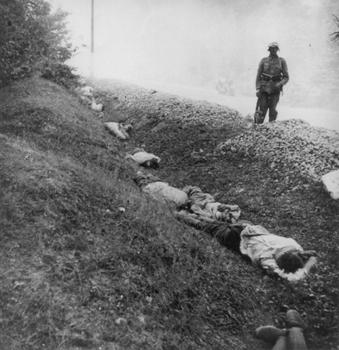Venom PL
Active member
The Polish September Campaign — known also as the "Polish-German War of 1939," in Poland sometimes as the "1939 Defensive War" (Wojna obronna 1939 roku), in Germany as the "Polish Campaign" (Polenfeldzug), and by the German General Staff codenamed Fall Weiss ("Case White") — was the World War II invasion of Poland by military forces of Nazi Germany and the Soviet Union and by a small German-allied Slovak contingent.
The campaign began September 1, 1939, one week after the signing of the secret Molotov-Ribbentrop Pact, and ended October 6, 1939, with Germany and the Soviet Union occupying the entirety of Poland. None of the major participants — Germany, the Soviet Union, Poland or the Western Allies — expected that this German invasion of Poland would lead to a war surpassing World War I in scale and cost.
The invasion of Poland marked the start of World War II in Europe as Poland's western allies, the United Kingdom and France, on September 3 declared war on Germany.
The September Campaign was the second military campaign to witness the use of German Blitzkrieg tactics (the Germans had first employed them in unofficial assistance to Francisco Franco in the Spanish Civil War).
Following the German-staged attack on 1 September 1939, German forces invaded Poland's western, southern and northern borders. Defending the long borders, the Polish armies were soon forced to withdraw east. After the mid-September Polish defeat in the Battle of Bzura, the Germans gained undisputed advantage. Polish forces then began a withdrawal south-east, following a plan that called for a long defence in the Romanian bridgehead area where Polish forces were to await an expected Western Allies counterattack and relief[7]. On September 17, 1939, the Soviet Red Army invaded the eastern regions of Poland. The Soviets were acting in co-operation with Nazi Germany, carrying out their part of the secret appendix of the Molotov-Ribbentrop Pact (the division of Europe into Nazi and Soviet spheres of influence), which secured Hitler's right flank, and allowed him to concentrate on attacking the Allies, without worrying about Soviet Russia to the east. In view of this unexpected Soviet aggression, the Polish government and its high command decided that the defence of the Romanian bridgehead was no longer feasible and ordered the evacuation of all troops to neutral Romania. By the beginning of October, Germany and the Soviet Union had completely overrun Poland. The Polish government (which never surrendered) together with many of its remaining land and air forces successfully evacuated to neighboring Romania and Hungary. Many of the evacuees subsequently joined the recreated Polish Army in allied France, French-mandated Syria and the United Kingdom.
In the aftermath of the September Campaign, Poland, even under occupation, managed to create a powerful resistance movement and contributed significant military forces to the Allies for the duration of World War II. Germany captured the Soviet-occupied areas when it invaded the Soviet Union (June 22, 1941), and the Soviet Union would later recapture these areas in 1944. Between them the German and Soviet occupations were responsible for the death of over 20% of Poland's citizens and the effective end of the Second Polish Republic.
Source - http://en.wikipedia.org/wiki/Invasion_of_Poland

German soldiers destroying Polish border checkpoint in Sopot on September 1939. Polish September Campaign and World War II in Europe begins. The image does not show the actual border crossing of 1 September 1939 but was staged a few days later.

Polish infantry in action

Motto painted on a German Ju-52 transport plane: "Whether figures, gasoline, bombs or bread, we bring Poland death."

German bombers over Warsaw.

Execution of some 300 Polish POWs at Ciepielów by the German 15th Motorized Regiment.

October 5, 1939: Wehrmacht parade down Warsaw's Aleje Ujazdowskie, watched by Adolf Hitler and other Nazi officials. During the parade, the city's population were ordered to stay home and keep their windows shut. To deter assassination attempts, the Germans held 412 civilians hostage. These included Warsaw University's most prominent professors as well as civilian city authorities, including Mayor Stefan Starzyński.

Shot down near Pabianice, Bf 110C (M8+AK). It was shot down on Sept. 2 by Cpl. Jan Malinowski from 162 Fighter Sqn.

Polish 40 mm Bofors M36 AA gun with C2P tractor











































































